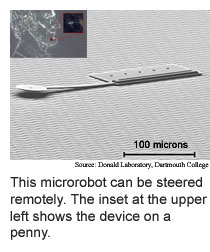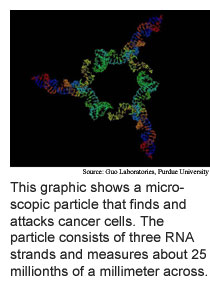
Week
of September 19, 2005
Honey,
I shrunk the robotic inchworm
Researchers from Dartmouth College and the Massachusetts Institute
of Technology have made tiny
mobile robots that are steerable. Although scientists have previously
made tiny mechanical devices from silicon, most of the devices are stuck
in place, and those that can move can only do so in a straight line.
 The Dartmouth-MIT microrobot is made from a single piece of 250-by-60-by-10
micron silicon. Human hair is about 75 microns in diameter.
The Dartmouth-MIT microrobot is made from a single piece of 250-by-60-by-10
micron silicon. Human hair is about 75 microns in diameter.
The robot has a rectangular body and a steering arm that protrudes
from its left side. It moves inchworm fashion, with the steering arm pivoting
the device by making contact with the surface. To turn right, the device
pivots through a full loop.
Microrobots like these could eventually be used to manipulate
individual cells in the body or in a biochip, repair computer chips and
investigate hazardous environments.
Don't worry about these particular tiny robots sneaking around
your desk drawers, medicine cabinet or body parts, though. They only move
around a special surface that provides power and control signals.
(A Steerable, Untethered, 250 X 60 Ám MEMS Mobile Micro-Robot,
12th International Symposium of Robotics Research, San Francisco, October
12-15, 2005)
Nano wireless
Fireflies, heart cells and pendulum clocks synchronize with others
of their kind. The same turns out to be true for nanoscale electromagnets,
which can be used to transmit and receive microwaves.
An experiment
conducted by researchers at the National Institute of Standards and Technology
(NIST) and Hitachi San Jose Research Center, and a second
experiment by researchers at Freescale Semiconductor Inc., show that
a pair of nanoscale magnetic oscillators in close proximity synchronize.
And as the oscillators vibrate in tandem, their output power increases
exponentially.
The oscillators are thin magnetic layers sandwiching a non-magnetic
layer. The magnetic layers are oriented in opposite directions, and under
a direct electrical current, their electrons align in opposite directions,
causing the device's overall magnetic orientation to rapidly oscillate.
These oscillations cause waves of magnetic alignment to ripple through
the electrons in surrounding material. The waves from a pair oscillators
in close proximity interact in such a way that they synchronize.
Arrays of nano-oscillators could be used to communicate information
sans wires between parts of a computer chip or between computer chips
within devices.
(Mutual Phase-Locking of Microwave Spin Torque Nano-Oscillators,
Phase-Locking in Double-Point-Contact Spin-Transfer Devices, Nature, September
15, 2005)
RNA nanotech takes on cancer
One of the great hopes for biomedical nanotechnology is that it
could lead to cancer treatments that are more effective and less harmful
than today's chemical and radiation therapies.
 Researchers from Purdue University have developed nanoparticles
that seek out, infiltrate and destroy cancer cells. The 25-nanometer-diameter
particles consist of short strands of RNA, the messenger molecule that
carries out instructions encoded in DNA for building the proteins that
regulate the body's biochemical processes.
Researchers from Purdue University have developed nanoparticles
that seek out, infiltrate and destroy cancer cells. The 25-nanometer-diameter
particles consist of short strands of RNA, the messenger molecule that
carries out instructions encoded in DNA for building the proteins that
regulate the body's biochemical processes.
The particles are made up of three hybrid RNA strands that include
molecules that find, mark or attack cancer cells. The strands are combined
into a triangular nanoparticle small enough to penetrate cancer cells.
The RNA nanoparticles interrupted the growth of human breast cancer
cells in laboratory tests and blocked tumor growth in mice, according
to the researchers.
The researchers developed some of their RNA-manipulation techniques
two years ago by building an RNA
nanomotor.
(Controllable Self-Assembly of Nanoparticles for Specific Delivery
of Multiple Therapeutic Molecules to Cancer Cells Using RNA Nanotechnology,
Nano Letters, September 14, 2005)
Physics finds file-folder formula
Natural networks like predator-prey relationships, social networks
like jazz musician collaborations, and artificial networks like the Internet
all have a scale-free structure, meaning they have a few nodes -- animals,
people or sites -- with many links, and many nodes with just a few links.
In these cases, the structure arises from the uncoordinated collective
action of many nodes.
The network of file folders in individuals' computer files also
has a scale-free structure, even though the structure is coordinated --
people decide how to set up their file folders. Researchers from Leipzig
University in Germany and the Mediterranean Institute for Advanced Studies
(IMEDEA) used statistical physics to study the file
directory trees of 63 computer users and developed a model that describes
the file folder structure.
The researchers found that file directory structures are strikingly
similar despite the lack of constraints on how people organize their files.
The work promises to improve tools for organizing and accessing information.
(Scaling in the Structure of Directory Trees in a Computer Cluster,
Physical Review Letters, September 16, 2005)
Bits and pieces
Electrically-driven crystal
growth powers a nanomotor; a self-assembled plastic
film that changes shape when it hits water or a pH change shows promise
for biomedical applications; an inexpensive supercapacitor
manufacturing process builds portable power into electronic devices.
RSS Feeds: News Blog Books New: TRN's Internet Services TRN's Jobs Center News: Research News Roundup Research Watch blog Features: View from the High Ground Q&A How It Works Buy an ad link |
|
| Advertisements: |
|
Ad links: Clear History
Buy an ad link
|
TRN
Newswire and Headline Feeds for Web sites
|